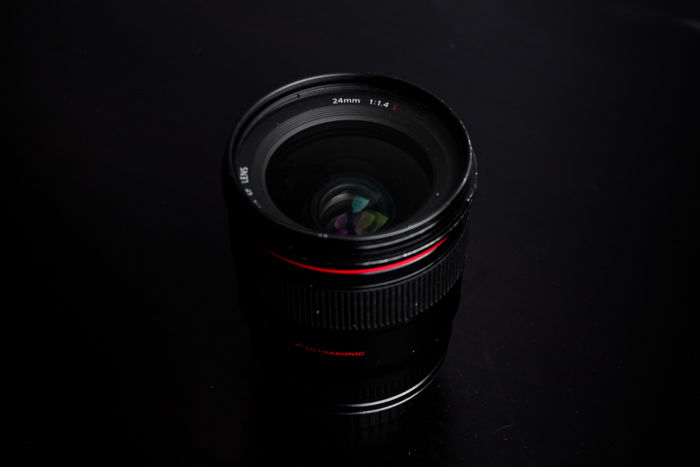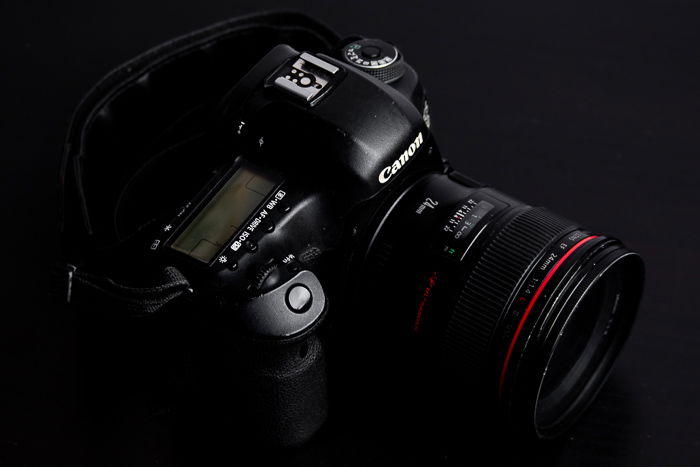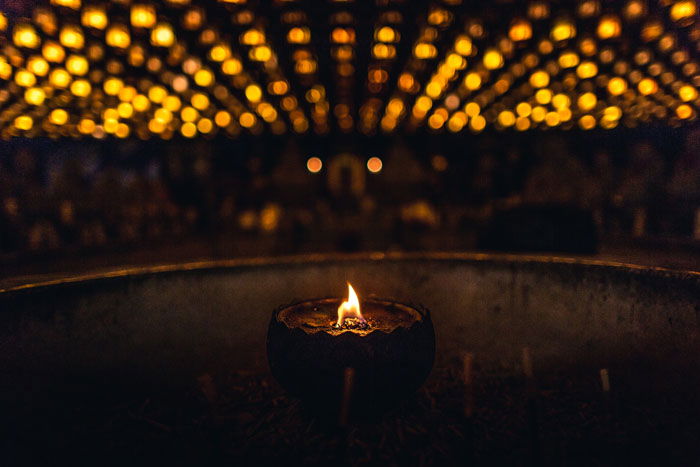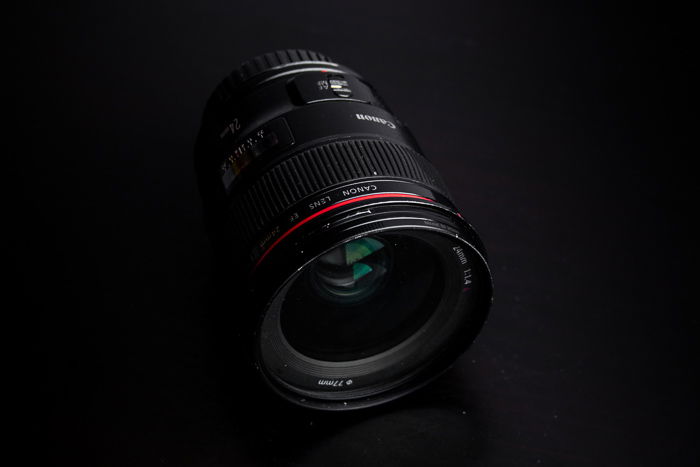The Canon EF 24 f/1.4L II USM is a wide-angle lens that’s perfect for landscape and travel photography. It offers superb image quality and a fast maximum aperture of f/1.4, making it ideal for shooting in low light conditions. The lens also features a weather-resistant construction, which makes it ideal for shooting in inclement .


| Brand |
Brand
Canon
|
| Lens Mount |
Lens Mount
Canon EF
|
| Maximum Aperture |
Maximum Aperture
f/ 1.4
|
| Focal Length Range |
Focal Length Range
24 mm
|
| Image Stabilization |
Image Stabilization
|
You might be concerned that this lens is 12 years old now, but don’t be: lenses don’t age like cameras, and this one is likely to remain Canon’s flagship 24mm lens for a while. For the new full frame mirrorless RF mount, I expect to see a dedicated version in the near future, though.
It’s an exceptional, but quite specialised lens. There are many alternatives on the market if you’re not looking for the large aperture specifically. I’ll mention more in the Alternatives section towards the end, but the most obvious ones the 24mm f/2.8 IS USM, the 28mm f/1.8 USM, or any of the 16-35mm f/2.8 zooms. There are 24mm f/1.4 lenses made by third-party manufacturers, too.
Please note that all sample images in this review were shot wide open at f/1.4, except where indicated.
In the box, there is a leather pouch, the EW-83K lens hood, and a user manual included.
As an L-series lens (Canon’s flagship line), its price is quite high. I found a fantastic deal on it second-hand, and honestly, that’s the reason I’ve got this lens. But after using it for almost three years now, I would get it at its full price without a second thought. However, this might not be the same for you.
A lens like this is not for everyone at all. There are three types of photographers (I can think of) that need a lens like the 24mm f/1.4. Let’s see them one by one.
The first and probably most populous is photojournalists, event photographers, and other documentarists, who need to capture motion in low light. For this task, I haven’t been able to find a better lens after years of searching. The f/1.4 aperture is able to give you near-freezing shutter speeds in very dark situations.
The autofocus is able to keep up with this in speed and accuracy – this is where most rivals fail. I’ve been shooting demonstrations, street events, concerts, and also nighttime street photography with this lens without any trouble.
The second is those after the very distinct look that a wide-angle, fast-aperture lens can provide. Despite the short focal length, you’re able to noticeably blur the background from 2-3 metres away at f/1.4. This aesthetic can give even the most boring scenes a special atmosphere, although don’t expect it to save your photos on its own.

The third is astrophotographers, who can really benefit from the immense light-gathering capabilities the 24 f/1.4 II offers. It can be useful for night-sky landscape shots, but also Milky Way or other Astro images. However, in this case, 24mm might be just a bit too tight. In all honesty, this is the area I’ve used this lens the least – I tried it a few times, but astrophotography has never really been my kind of thing.
Furthermore, the EF 24 f/1.4 II is an exceptional lens for video shooters. It’s got a beautiful, signature look, great contrast and sharpness, and no visible distortion. It has a long-throw and precise manual focus ring with mechanical contact, so manual focusing with it is as good as it gets. The 24mm focal length is useful both in full frame and Super35 crop modes (which is roughly similar to an APS-C crop).
One thing to note is that you need a full frame camera to fully appreciate and use this lens for photography. When you’re in a price range higher than the cost of a lower-end (or a second-hand professional) full frame DSLR, you don’t want to throw away half of your frame. You don’t get the maximum out of this lens with a crop sensor camera in any of the above-listed use cases.

We also need to talk about the use cases that don’t demand a lens like this. These include landscape, still life, portrait, street, travel, family, architecture, real estate, food, and many more genres of photography. Of course, I myself use it for some of these, but only because I’ve got it already, not the other way around.
The Canon EF 24mm f/1.4L II USM is made primarily for full frame EF-mount cameras. These are the Canon EOS 6D, EOS 5D, and EOS 1DX/1Ds series of digital cameras, as well as all of Canon’s 35mm film cameras since 1987. It can also be adapted without loss in autofocus speed to Canon’s full frame mirrorless R bodies (currently the R, RP, R6, and R5). I actually used it to test and review the EOS RP, as I found them to be a great, small combination.
Even if I don’t recommend this, the lens will work perfectly on crop sensor EOS DSLR bodies (such as the 7D, 10D-90D series, and all the Rebels). It will work just fine with a slight drop in autofocusing speed on Canon’s crop sensor mirrorless EF-M-mount cameras.
You can also use any EF mount adaptor currently on the market with this lens. These include adaptors to Sony E-mount, Nikon Z-mount, Leica L-mount, and more. For Micro Four Thirds, I recommend using a speed booster do retain some of the low light advantages. With a 0.64x Metabones adaptor, for example, it will become a 15mm f/0.9 lens. Autofocusing speed and reliability on these non-Canon cameras will depend on the quality of the adaptor used.
The optical performance of the EF 24mm f/1.4L II USM is stellar. Right from f/1.4, the center is razor-sharp, although there’s some work to do in the corners. However, even those are crystal-clean and sharp by f/2. The lens reaches its sharpness peak at f/2.8, there’s no getting better from there, and from f/11 it starts to soften due to diffraction. This is one stop lower than where most lenses start showing signs of diffraction, and it illustrates how sharp this lens really is.
However, sharpness is not the sole reason it’s so outstanding. Distortion is another. Of all Canon lenses that contain the 24mm focal length, it’s by far the best performer. It shows no apparent distortion at any focusing distance.
Micro-contrast is also excellent. Many photographers believe that micro-contrast is a better indicator of a lens’ quality than sheer sharpness, and there’s something to this. You won’t notice how sharp a lens really is on a web-sized image, but you’re very much able to tell if it looks contrasty and rich. Just like sharpness, this is impossible to truly reproduce in editing software.

The out-of-focus backgrounds, of which you get plenty, are beautiful and creamy, with soft transitions. Even towards the full frame corners, the bokeh balls are perfectly circular and show no aberrations.
Chromatic aberration is the only area of image quality where the 24mm f/1.4 II lens doesn’t outperform the entire market. There is some visible fringing on contrasty edges, and also on out-of-focus contrasty areas. I generally find it easily removable during post-production, and it doesn’t even always show up. But it’s definitely there most of the time.
Flaring is fairly well-controlled, the lens retains contrast beautifully even in direct sunlight. The hood does a great job, but it’s almost never necessary just for blocking sunlight. It’s great for protection and making the camera look beefier, though.
The ultrasonic autofocusing motor (‘USM‘ in the name) in the 24mm f/1.4 II is accurate and responsive. It can keep up with any movement in daylight and does an excellent job in low light as well. It’s almost completely silent, although the camera microphone can pick up a slight whirring noise when the focusing elements move.
The manual focus ring is mechanically coupled to the focusing elements. When you autofocus, the ring doesn’t move, but you can always turn it yourself to override the autofocus action. The ring itself is precise, which is great for videomakers and photographers alike. From infinity to close focus, it’s about a 135-degree turn.
When focusing, nothing moves on the outside. There is a focusing distance scale on the lens, as well as depth of field markings for all full apertures up to f/22. The minimum focusing distance is 0.25m.

The 24mm f/1.4 II is sturdy and durable. Built entirely of metal (even the filter thread), this lens is designed for the beat-up nature of photojournalistic work.
It’s fully weather-sealed, which I had the fortune of witnessing on a few occasions. It easily withstands pouring rain with 5D-series bodies. I have personal evidence that it’s also dustproof. The 5D MkIII camera that came with this lens when I bought it second-hand was full of sand and salt, but the lens itself was completely clean on the inside.
On the side, there is a single manual/autofocus switch.
It weighs 650g without the hood, balancing excellently with 7D, 5D, and 1D-series bodies. It’s 87mm long, and 93.5mm in diameter.
It has a 77mm filter thread, which is the standard for this type of lens, and one of the most-used sizes. Filters this size are not cheap, especially high-quality ones.
The included EW-83K hood is plastic with a velvet-like light-absorbent material on the inside. As it’s not really needed for actual flare reduction, only protection, once you lose or break the first hood, I don’t recommend buying a new Canon one. It costs around $50, for which you can get five no-name plastic hoods which will protect the lens just as well.
There are a number of alternatives to the EF 24mm f/1.4L II USM.
The most direct one is the Sigma Art 24mm f/1.4. This lens costs about half of the Canon version, and it’s almost there optically. It’s not as well-built as the Canon, but decent on this front as well. However, it’s known to have some focus reliability issues and more sample variation. If you have room for error in focusing, consider getting this one instead, but if you don’t, your choices are narrowed.
The Samyang/Rokinon 24mm f/1.4 is a fully manual lens appealing mostly to astrophotographers and video shooters. It’s slightly behind optically, it’s not sealed, and it doesn’t autofocus – but at a third of the price, you still the f/1.4 and good image quality.
The Canon EF 24mm f/2.8 IS USM is a smaller, slower alternative. Stopped down to f4, it’s almost indistinguishable from its L-series counterpart in image performance. It’s much smaller and lighter and even has half-decent image stabilization. If you like the 24mm focal length but don’t need immense low-light performance, this might be ideal for you.
The Canon EF 28mm f/1.8 USM is similar in low-light performance, but it comes with its own sacrifices, mostly on the optics field. This lens is sharp, but it cannot measure up to either 24mm lens anywhere but in the center. Yet, it’s great for getting similarly blurred backgrounds at a similarly wide angle.
The Canon EF 16-35mm f/4 IS USM should be your choice for landscape photography. Despite being a zoom lens, its image quality is almost indistinguishable from the 24mm f/1.4. So, if you don’t need the fast aperture, this is a cheaper and more versatile option.
The EF 24mm f/1.4 II is a stellar lens and one that’s been my workhorse and favourite for years. It’s a speciality tool, and if you find yourself needing one, it will set you back by a decent sum.
But it can just as easily return the investment, and give you unmatched visual pleasures on the way. If you choose to get one, you can hardly go wrong with it.
amzn_assoc_tracking_id = “expertphotog-20”;
amzn_assoc_ad_mode = “manual”;
amzn_assoc_ad_type = “smart”;
amzn_assoc_marketplace = “amazon”;
amzn_assoc_region = “US”;
amzn_assoc_design = “enhanced_links”;
amzn_assoc_asins = “B001GNCWCE”;
amzn_assoc_placement = “adunit”;
amzn_assoc_linkid = “b43dea29828e6f56c65e21f18abc95fa”;
| Measurement |
Measurement
Score
|

